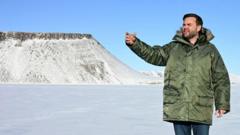During a recent visit to Greenland, Vice President JD Vance encountered frigid temperatures and a challenging political landscape while underscoring President Trump's insistence on acquiring the territory. The trip served as a reminder of the complexities surrounding U.S. foreign aspirations and the longstanding interest in Greenland.
### Vice President Vance's Greenland Visit: A Diplomatic Chill

### Vice President Vance's Greenland Visit: A Diplomatic Chill
**A strategic exploration or territorial ambition? An analysis of Vance's trip to Greenland amid chilly weather and political tensions.**
---
On March 28, 2025, Vice President JD Vance embarked on a visit to Greenland, engaging in a diplomatic effort while simultaneously adhering to President Trump's contentious desire to acquire the territory. In a statement underscoring Trump's views, Vance emphasized that Greenland is vital to U.S. national interests, imparting a sense of urgency on the matter.
Amid the picturesque yet frigid landscapes of the Arctic, which saw temperatures plunge to minus 3 degrees, Vance made headlines for both his jovial remarks and the serious undertones of the visit. The base he toured, formerly known as Thule Air Force Base, has historically been of strategic importance, contributing to the American military presence in the region. Yet, this visit was marked by an evident lack of public enthusiasm, as protesters were relegated outside the controlled environment of the base.
Vance's humor about the weather—despite wearing minimal cold protection—brought laughter among military personnel but also highlighted the harsh realities of working in such extreme conditions. His remarks pointedly reflected a deeper narrative regarding U.S. interests in Greenland, as the administration continues to grapple with challenges in fostering international relationships and addressing climate impact.
President Trump reiterated his firm stance in the Oval Office, asserting that America could not "live without" Greenland. This determination raises questions about the administration's approach to diplomacy within a geopolitically sensitive Arctic. Analysts have pointed out that the cold reception, both literally and figuratively, reflects historical complexities and the potential backlash against perceived aggressive territorial ambitions.
As the U.S. pursues its strategic interests in Greenland, the balance between diplomacy and ambition becomes increasingly delicate, requiring thoughtful engagement to avoid exacerbating tensions while navigating the realities of climate change, indigenous rights, and international collaboration in the Arctic region.
On March 28, 2025, Vice President JD Vance embarked on a visit to Greenland, engaging in a diplomatic effort while simultaneously adhering to President Trump's contentious desire to acquire the territory. In a statement underscoring Trump's views, Vance emphasized that Greenland is vital to U.S. national interests, imparting a sense of urgency on the matter.
Amid the picturesque yet frigid landscapes of the Arctic, which saw temperatures plunge to minus 3 degrees, Vance made headlines for both his jovial remarks and the serious undertones of the visit. The base he toured, formerly known as Thule Air Force Base, has historically been of strategic importance, contributing to the American military presence in the region. Yet, this visit was marked by an evident lack of public enthusiasm, as protesters were relegated outside the controlled environment of the base.
Vance's humor about the weather—despite wearing minimal cold protection—brought laughter among military personnel but also highlighted the harsh realities of working in such extreme conditions. His remarks pointedly reflected a deeper narrative regarding U.S. interests in Greenland, as the administration continues to grapple with challenges in fostering international relationships and addressing climate impact.
President Trump reiterated his firm stance in the Oval Office, asserting that America could not "live without" Greenland. This determination raises questions about the administration's approach to diplomacy within a geopolitically sensitive Arctic. Analysts have pointed out that the cold reception, both literally and figuratively, reflects historical complexities and the potential backlash against perceived aggressive territorial ambitions.
As the U.S. pursues its strategic interests in Greenland, the balance between diplomacy and ambition becomes increasingly delicate, requiring thoughtful engagement to avoid exacerbating tensions while navigating the realities of climate change, indigenous rights, and international collaboration in the Arctic region.



















